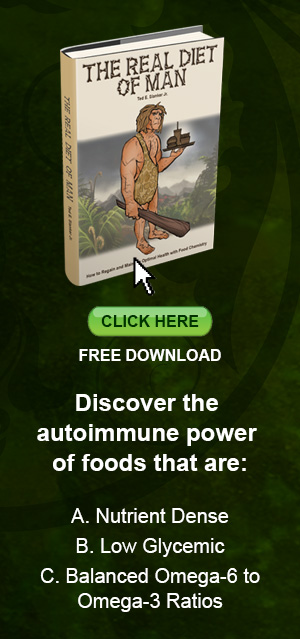How You Can Improve Your Health With Grass-Fed Meats
All livestock, cattle included, evolved on a diet of green leafy plants (mostly grass). That is God's way. That's because the green plant came before animals. The green plant was the first sustainable life form. Only with it could an animal kingdom exist. Consequently, for all of time animals ate virtually no grain. (Grain is the seed of a land-based annual grass plant.) They either ate green plants and/or they ate other animals that ate green plants and/or other animals. Consequently, the green plant has always been at the bottom of the food chain.
These straightforward facts are very important because nutritional scientists report that many of America's leading health problems are caused by diets top heavy in omega-6 fatty acids versus omega-3 fatty acids. Quantities of Omega-6 fatty acids are very high relative to Omega-3 fatty acids in grain, nuts, some fruits, some vegetables, and all grain-fed animal products. On the other hand, Omega-3 fatty acids are about evenly balanced with Omega-6 fatty acids in green leafy plants (on land and in the sea). Therefore, it can be said that the only reason you hear about the need for Omega-3 fatty acids today is because our nation has a grain-based food system that is deficient in Omega-3 fatty acids and many other important nutrients.
Beginning in the late 1970s dietitians and scientists started making new discoveries about fat. One major discovery was that some fatty acids are essential for human health. Essential nutrients are those our bodies do not make. Some of the most crucial fatty acids for optimizing body function are those found in the membranes (cell walls) of all cells, especially those located at the nerve synapses in the brain.
It has been determined that the human body and the bodies of all animals require an appropriate balance of the essential fatty acids (EFAs) in the diet in order to promote optimal body function. The balance of EFAs in the foods animals eat is critical because animal bodies cannot manufacture the essential fatty acids. The EFAs can only come from food, and if the ratio of fatty acids in the overall diet is out of balance the body cannot compensate for the deficiencies or surpluses.
Two key EFAs are the omega-6 and omega-3 fatty acids. Scientific experiments have determined that when the ratio of omega-6 fatty acids to omega-3 fatty acids in the diet exceeds 4:1, people develop chronic diseases (body failures). That's why knowing the fatty acid ratio of the food in your overall diet is very important. Grain-fed beef can have up to a 20:1 ratio. That's because the corn they eat has a 30:1 ratio! The ratio for grass-fed beef is around 1:1. These ratios are similar for all grain-fed versus grass-fed meat, poultry, and dairy products.
The short list of ailments caused or exacerbated by diets high in omega-6 fatty acids and low in omega-3 fatty acids include ADHD, arthritis, asthma, autism, cancer, chronic fatigue syndrome, diabetes, heart disease, obesity, stroke, bipolar, osteoporosis, hay fever, allergies, gout, autoimmune disorders, thyroditis, multiple sclerosis, systemic lupus erythmematosus, acne, Parkinson's, Alzheimer's, Crohn's and the list goes on and on. These ailments are not caused by bacterial infections. They are literally created by bodies failing to function properly. Aging doesn't have anything to do with this problem. It's a nutritional deficiency problem, like scurvy was for sailors of old.
The science behind fatty acid ratios makes the health benefits of naturally raised, grass-fed beef and other grass-fed livestock products rather ironclad. Yet there is much more to the story. For instance, dietitians point to CLA (conjugated linoleic acid) a fatty acid that reduces the risk of cancer, obesity, diabetes, and a number of immune disorders such as lupus and arthritis. It too comes from grass, and grass-fed beef can have up to 20 times more CLA than grain-fed beef.
There is no question that livestock are what they eat. For a fact they are healthier when they are raised on lush grasslands rather than grain. Just like livestock, humans are what they eat. This means good health stems from a proper diet and that can lead to better self-esteem, reduced health care costs, a longer life, a feeling of security, improved mental alacrity, and true independence.
Here is how you can improve your health with grass-fed meats:
Obesity: Most Americans struggle with obesity. The average American eats 66.5 pounds of beef per year (a paltry sum). A switch from grain-fed beef to grass-fed beef saves 17,733 calories per year. Better yet, obese people who change their diets to foods providing the proper fatty acid ratio can lose weight while consuming the same number of calories. 1
Diabetes: A diet enriched with omega-3 fatty acids can help prevent insulin resistance in humans for it will lower body weight, blood pressure, and triglyceride levels. 2
Heart Disease: After cattle have spent four to six months in a feedlot eating grain, their meat has four to six times more fat, twice as much saturated fat, and as little as 1/10 the quantity of omega-3 fatty acids compared to meat from grass-fed cattle. 3 People with diets rich in omega-3 fatty acids are less likely to have high blood pressure or irregular heart rhythms, and are half as likely to die from heart attack or stroke. 4
Cancer: Heart patients who followed an omega-3-rich diet for three years not only had a 70% reduction in the risk of dying from a heart attack, they had a 61% reduction in the risk of dying from all types of cancer. 5
Mental Disorders including Attention Deficit Syndrome and Alzheimer's Disease: Your brain is largely composed of fat, and omega-3 fatty acids are the most important of those fats. That's why a diet with an adequate level of omega-3 fatty acids will lower the risk of mental disorders including depression, aggressive behavior, attention deficit disorder, schizophrenia, and dementia. 6 and 7
E. Coli: Livestock fed corn silage and animal byproducts are more likely to carry E. coli 0157:H7 than other livestock, such as grass-fed livestock. 8 The gastric juices in the human stomach destroy 99.99% of the normal type of E. coli found in grass-fed livestock. A high percentage of the acid resistant E. coli from grain-fed livestock will survive the same acid bath in the human stomach and can cause major health problems. 9
These are only a few of the health benefits that are gained from eating grass-fed livestock products. Besides health there are additional benefits from raising livestock on lush grasslands; their natural environment. Nutrients are recycled naturally resulting in healthier soils and pastures. The economics of agriculture shifts away from confinement operators back to local producers in the rural communities. And the list goes on.
For considerably more information about food, the science of fatty acids, the diet of man prior to his invention of grain farming, the Paleo and Caveman diets, and more go to Omega-3 Essays. This article is only a basic introduction to the subject.
1. Ikemoto, S., O. Ezaki, M. Takahashi (1996) Metabolism 45(12): 1539-46.
2. Torgensen, P.A., et al. (1997) Diabetes Care 30:26-31.
3. Fukumoto, G.K., Y.S. Kim, D. Oduda, H. Ako (1995) Reaserch Extension Series 161:1-5.
4. Hu, F.B., M.J. Stampfer, et al. (1999) American Journal of Clinical Nutrition 69(5):890-7.
5. de Lorgeril, M., P. Salen, et al. (1998) Archives of Internal Medicine 158(11):1181.
6. Hibbein, J.R., N. Salem (1995) American Journal of Clinical Nutrition 62:1-9.
7. Schaefer, E.J. “Decreased Plasma Phosphatidylcholine Docosohexaneoic Acid Content in Dememtia.”
8. Herriott, D.E., D.D. Hancock, et al. (1998) Journal of Food Protection 61(7):802-7.
9. Diez-Gonzalez, F., T.R. Callaway, et al. (1998) Science 281(5383): 1666-8.




